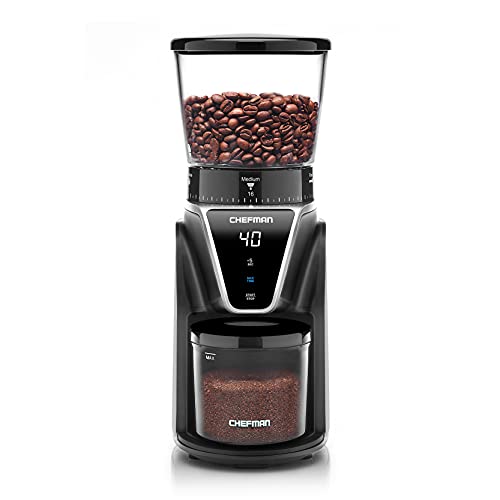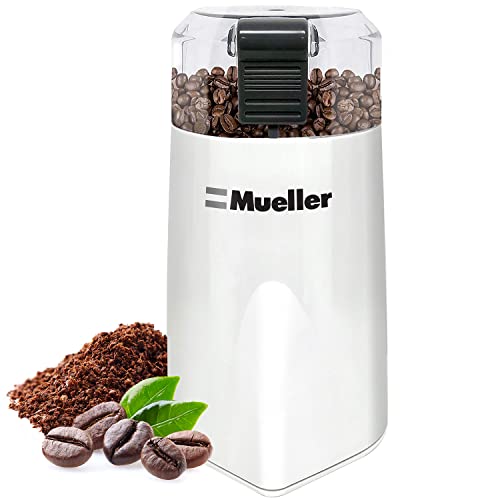Our content is meticulously curated through independent research, testing, reviews, and AI-driven recommendations, all designed to present you with the finest product choices. When you make a purchase through our links, it could result in us earning a commission.

Coffee enthusiasts and occasional coffee drinkers alike understand the importance of evenly-grinded coffee beans when making the perfect cup of coffee. A coffee grinder is an appliance that grinds coffee beans until they’re suitable for brewing; a grinder can be motorized or manual and can control how finely the beans are ground. Coarsely and unevenly ground coffee beans make it very hard for the water to extract flavor from them, making the end result a weak cup of coffee that lacks flavor.
Our review examined each coffee grinder’s size, speed, grind settings, and style. Our favorite is the Chefman Coffee Grinder because of its wide range of grind settings and large coffee bean capacity.
.
A coffee grinder is a machine that grinds coffee beans into coffee powder, which can then be used to make coffee. There are different types of coffee grinders, and each one produces a different type of powder. Freshly ground coffee beans give the coffee a richer flavor and aroma, but the type of powder a grinder produces will affect the flavor of the coffee made from it. Most people prefer a coffee grinder because it gives them more control over the final product. It also lets you control the size of the crushed beans so you can make a finer or coarser powder, depending on your preference.
Pre-ground coffee is coffee that has been ground before it is brewed. This means that the coffee beans have been sitting around for a while and have lost flavor and aroma. On the other hand, freshly ground coffee will have a richer flavor and aroma because the coffee beans have not had time to lose their flavor. Another difference is that most types of pre-ground coffee beans tend to go stale quicker since it is exposed to air. Most coffee grinders let you select how much coffee you're grinding, so you always have a fresh batch.
There are two main types of coffee grinders: blade and burr.
Blade grinders are the more affordable option and work by chopping up the coffee beans with a rapidly spinning blade. This results in uneven grinds, leading to an inconsistent cup of coffee. But, since blade grinders are affordable and easy to clean, they're a good option for beginners. You can take apart the grinder to wash it in many cases, which is helpful if coffee grounds get stuck in the blades.
Burr grinders, on the other hand, use two burrs (one stationary and one rotating) to crush the beans into uniform grinds. This results in a more consistent cup of coffee. Burr grinders are more expensive, but many coffee aficionados feel they're worth the investment. One thing to remember is that burr grinders can be a pain to clean because the coffee grinds can get stuck in the burrs. Furthermore, some burr grinders do not open up, so you can't remove the coffee grinds from the inside.
The next thing to consider is the coffee beans you want to grind. Different coffee grinders are better at grinding different types of beans. You might not need to worry about this if you only drink one kind of coffee, but if you like to experiment with different types of coffee, you'll need a grinder that can handle different bean types.
The grind settings are also essential to consider, as the number of grind settings will determine how much control you have over the final product. Get a coffee grinder that can produce the type of powder you want.
You also must ensure that the coffee grinder you choose is the right size for your needs. Consider how much counter space you have and how easy it is to store. If you take your coffee grinder with you on trips, you'll need to ensure it's lightweight and portable.
Although this should be obvious, one must remember to always unplug the coffee grinder before taking it apart. The burrs and blades in the grinders are sharp; hence, one must always be careful when removing them. Lift out the burs and or blade as instructed. If you can’t remove them, try taking out the grinding chamber as a whole.
Usually, it is suggested that you 'bang' out the residue from your coffee grinder by hitting it against the countertop. For better results, gently tap the coffee grinder to dislodge the grime or excess ground coffee stuck in it. Start by turning your grinder upside down over a sink or newspaper. Gently start tapping the flat surface of the grinder, increasing force if the residue is not dislodging.
This might seem like the easiest step when it is far from it. The residue from grinding coffee sticks to every surface it meets. Simply wiping it off does not do any good, and gives you the urge to use a damp cloth or towel. A wet cloth does not help remove the residue but only makes it damp, causing the coffee made in the grinder to taste off and accumulate even more residue. The best option is to make use of a microfiber cloth.
Many nooks and crevices inside a coffee grinder can’t be cleaned using a microfiber cloth alone. Consider targeting these areas using a cleaning brush to dislodge leftover coffee grounds. Some common household items such as Q-tips, toothpicks, and toothbrushes can be used to target a specific area in the grinder. The small contact surfaces or bristles are vital for dislodging any remaining residue. If these coffee grounds are stubborn and do not dislodge, you can use a can of compressed air to make things easier.
Most people notice a slight difference in the taste of their coffee once they have cleaned their grinders. To avoid this, you must bring back the coffee grinder’s ‘used’ taste. This process is known as seasoning. In seasoning, you take the freshly cleaned coffee grinder and start by adding a new round of coffee to the grind. Using coffee oil is also another good option. Just remember that you must throw away the ground coffee used for the seasoning process. After this, your coffee grinder will make the perfect cup every time.

| Pros | Cons |
|---|---|
|
|

| Pros | Cons |
|---|---|
|
|

| Pros | Cons |
|---|---|
|
|

| Pros | Cons |
|---|---|
|
|

| Pros | Cons |
|---|---|
|
|

| Pros | Cons |
|---|---|
|
|